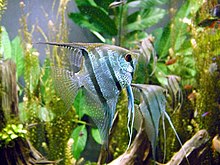Pterophyllum
| Freshwater angelfish | |
|---|---|
 |
|
 |
|
| Scientific classification | |
| Kingdom: | Animalia |
| Phylum: | Chordata |
| Class: | Actinopterygii |
| Order: | Perciformes |
| Family: | Cichlidae |
| Tribe: | Heroini |
| Genus: |
Pterophyllum Heckel, 1840 |
| Type species | |
|
Platax scalaris G. Cuvier, 1831 |
|
Pterophyllum is a small genus of freshwater fish from the family Cichlidae known to most aquarists as "angelfish". All Pterophyllum species originate from the Amazon Basin, Orinoco Basin and various rivers in the Guiana Shield in tropical South America. The three species of Pterophyllum are unusually shaped for cichlids being greatly laterally compressed, with round bodies and elongated triangular dorsal and anal fins. This body shape allows them to hide among roots and plants, often on a vertical surface. Naturally occurring angelfish are frequently striped longitudinally, colouration which provides additional camouflage. Angelfish are ambush predators and prey on small fish and macroinvertebrates. All Pterophyllum species form monogamous pairs. Eggs are generally laid on a submerged log or a flattened leaf. As is the case for other cichlids, brood care is highly developed.
The currently recognized species in this genus are:
The freshwater angelfish (P. scalare) was described in 1824 by F. Schultze. Pterophyllum is derived from the Greek πτερον, pteron (fin/sail) and φυλλον, phyllon (leaf).
In 1906, J. Pellegrin described P. altum. In 1963, P. leopoldi was described by J. P. Gosse. Undescribed species may still exist in the Amazon Basin. New species of fish are discovered with increasing frequency, and, like P. scalare and P. leopoldi, the differences may be subtle. Scientific notations describe the P. leopoldi as having 29–35 scales in a lateral row and straight predorsal contour, whereas, P. scalare is described as having 35–45 scales in a lateral row and a notched predorsal contour. P. leopoldi shows the same coloration as P. scalare, but a faint stripe shows between the eye stripe and the first complete body stripe and a third incomplete body stripe exists between the two main (complete) body stripes that extends three-fourths the length of the body. P. scalare's body does not show the stripe between the eye stripe and first complete body stripe at all, and the third stripe between the two main body stripes rarely extends downward more than a half inch, if even present. P. leopoldi fry develop three to eight body stripes, with all but one to five fading away as they mature, whereas P. scalare only has two in true wild form throughout life.
...
Wikipedia
